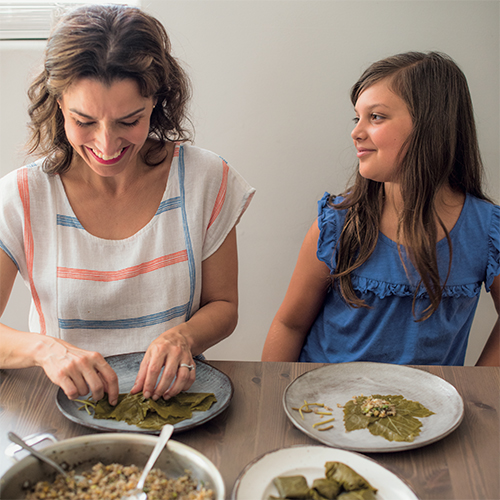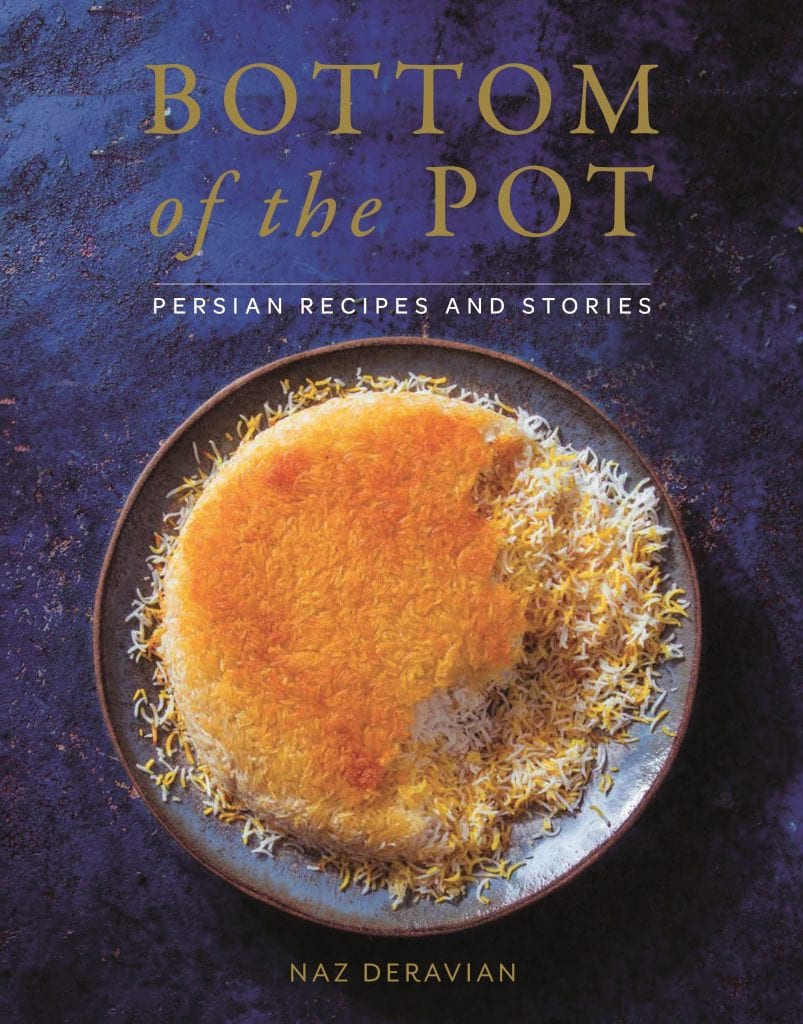
As I turned the pages of Naz Deravian’s cookbook, “Bottom of the Pot, Persian Recipes and Stories,” I was instantly hooked. This is the food of my childhood and carries memories of growing up in an immigrant family in L.A. I was 9 years old when we left Iran, and while just about everything was different here, one thing remained a constant – my mom’s cooking. Every day, our house was filled with the intoxicating aromas of saffron, dill, mint, fenugreek and tarragon. In many ways, cooking and gathering together around a pot of aash (a Persian soup), a platter of barberry rice or a bowl of maast-o-khiar (yogurt and cucumber) was our lifeboat during those turbulent early days in the U.S.
Deravian also left Iran as a child in the midst of the 1979 revolution, settling in Canada with her family and eventually moving to L.A., marrying an American and becoming a mom. Her cookbook is like a love letter to her roots, her family and to the incredible ability of food to bring us together as a community, to “nourish, soothe, cure, celebrate and unite,” as she writes.
I met Deravian at a coffee shop in Westwood, in the heart of Little Tehran, to talk cooking and family. It turns out she wasn’t always a great cook. She had to learn after moving to L.A. by herself to pursue an acting career. She was homesick and “really hungry.” When she called her mom to ask how to re-create a few of her favorite dishes, she discovered that Persian recipes are not written down on index cards, but shared orally through stories. Persian cooking relies on intuition, feeling and learning to trust yourself, Deravian explains. Being at ease in the kitchen and allowing yourself to experiment with herbs and spices is a theme she emphasizes throughout her book, which is a wonderful collection of recipes and family stories of the past and present.
Her goal is to introduce Persian cooking and capture the sense of warmth and hospitality she felt growing up. The book does a great job of explaining the best preparation and storage methods for saffron, pomegranate molasses, cardamom, dill, mint and other common flavors used in Persian cooking. The great news for us living in L.A. is that we have access to so many Middle Eastern markets. And Deravian encourages families to venture into these markets and pick up something new – like a bottle of rose water to make a baghlava cake.

“We love living in Los Angeles and raising our daughters here,” Deravian says. “The diversity of cultures here is beautiful and special. It allows all of us space to be and to appreciate and learn from one another. And what better way to come together than through delicious food?”
She says this simple and flavorful turmeric chicken dish is “the workhorse of our weeknights,” the dish her mother would prepare when she didn’t want to think about what to cook. She says you can serve the meat on or off the bone, and can ask your butcher to remove the chicken skin. You can also do it yourself easily by holding the bottom of the drumstick with a paper towel with one hand as you slip the skin off with a paper towel with the other hand.
Deravian suggests using this recipe as a canvas and experimenting with a few sprigs of rosemary for a fresh, earthy note, or a little tomato paste for a richer red sauce.
Everyday Turmeric Chicken (Morgh ba Zardchoobeh)
From “Bottom of the Pot: Persian Recipes and Stories,” reprinted with permission from Flatiron Books.
Serves 4 to 6
10 skinless chicken drumsticks (about 3 pounds)
1 teaspoon ground turmeric
2½ teaspoons kosher salt (plus more as needed)
¼ teaspoon ground black pepper (plus more as needed)
3 tablespoons olive oil
1 medium yellow onion, diced
2 cloves garlic, chopped
Splash of white wine (optional, if you happen to have some open)
2 tablespoons fresh lemon juice
Parsley, as a garnish (optional)
Make a couple of slits in the flesh of each drumstick. This allows the drumsticks to cook faster and for all the flavors to seep in. In a bowl, season the drumsticks with the turmeric, salt and pepper. Set aside.
The chicken can be prepared a few hours in advance, but leave the chicken in its juice in the pot. You might need to drizzle in a little more water when reheating.
Add the drumsticks to the pan. It’s OK if they overlap a little, just scoot them around once in a while. Cook until the chicken takes on a little color, about three minutes on each side (total time, six minutes). Add the lemon juice and a scant quarter cup of hot water. Turn the chicken pieces in the sauce to coat all sides and scrape up all the crispy bits. Reduce the heat to medium-low, partially cover and simmer, turning once in a while, until the chicken is cooked through and tender, about 35 minutes. Taste as it cooks and make delicious. Does it need more salt, pepper or lemon juice? When done, garnish with parsley, if using, and serve.
In a large pan with a lid (a 12-inch one works well), heat the oil over medium heat. Add the onion, sprinkle with a little salt and cook, stirring occasionally, until soft and golden, about eight minutes. Add the garlic and cook for two minutes. Splash with the wine (if using).
The finished dish can be stored in the refrigerator for up to three days or in the freezer for up to three months.


























